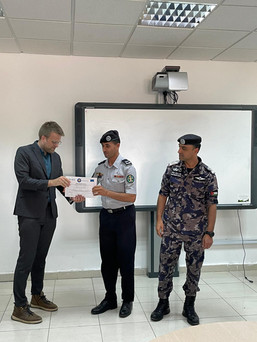Introduction
The PPRD Med training program was designed to equip participants with a comprehensive understanding of flood modeling and risk assessment tools. The agenda included a mix of theoretical knowledge and practical exercises to ensure a well-rounded learning experience.

Fast Flood modeling software and flood modeling techniques
The session started with a comprehensive overview of the main features of the flood modeling software. Participants were introduced to the methodology behind the software, which included a detailed explanation of its underlying principles and the theoretical framework it uses. The session also covered the various assumptions the software makes during the modeling process. These assumptions are critical as they influence the accuracy and applicability of the model in different scenarios. Additionally, the scope of the software was discussed, outlining the types of flooding events and geographical areas it can effectively model. The limitations of the software were also highlighted, providing participants with a realistic understanding of its capabilities and the contexts in which it might not perform optimally.
Following the overview of the software features, the training delved into specific flood modelling techniques. This segment focused on the different types of input data required for accurate modelling, such as topographical maps, soil characteristics, and historical flood data. The importance of scale was emphasized, explaining how the model adjusts to different spatial resolutions and geographic extents. Participants learned about the behavior of water flow in various environments, including urban areas, river basins, and floodplains. This included a discussion on how the software simulates flow behavior under different conditions. Meteorological variables, such as rainfall intensity and duration, were also covered, highlighting their significant impact on flood predictions. Finally, the probability of flooding events was addressed, with participants learning how to interpret and utilize probabilistic data to assess flood risks accurately. This comprehensive approach ensured that participants gained a thorough understanding of both the theoretical and practical aspects of flood modeling.
Interactive sessions on Flash Floods, fluvial floods, dam breaks scenarios, and model calibration
The session included interactive components dedicated to setting up simulations for various types of floods. Participants engaged in hands-on activities that focused on creating simulations for flash floods, fluvial floods, and dam breaks. These simulations were particularly detailed, including scenarios specific to regions like the Jordan Valley. This practical approach allowed participants to apply theoretical knowledge to real-world situations, enhancing their understanding of how different flooding events can be modeled and predicted using the software.
In addition to setting up simulations, the session also covered the essential topic of model calibration. An overview of various calibration methods was provided, explaining the techniques used to adjust the model to ensure its accuracy and reliability. Participants then took part in an interactive session dedicated to the calibration of the model. This exercise involved using actual data to fine-tune the model parameters, thereby improving its predictive performance. By working through these calibration exercises, participants gained valuable insights into the process of validating and optimizing flood models, making them better equipped to handle real-world flooding scenarios effectively.
Industrial risks and modeling tools
The training session also covered critical aspects of industrial risks and the tools used to model these hazards. Participants were provided with an overview of the most common industrial risks, including chemical spills, explosions, and other industrial accidents. The session detailed the potential effects of these risks on the environment and human health, emphasizing the importance of accurate risk assessment and management.
Following the theoretical overview, the session included a demonstration of the modeling tools Aloha and PRIMARISK. These tools are essential for evaluating industrial risks and planning mitigation strategies. The demonstration showcased how Aloha can be used to model the dispersion of hazardous chemical releases, providing real-time data on the potential impact areas. Similarly, PRIMARISK was demonstrated to help assess the probability and consequences of various industrial hazards. Participants learned how to input data, interpret the results, and use these tools to make informed decisions about industrial risk management. This combination of theoretical knowledge and practical application ensured that participants were well-equipped to handle industrial risks using state-of-the-art modeling tools.
Quiz and certificate
The final segment of the training session focused on evaluating the participants' grasp of the material covered. To achieve this, a comprehensive assessment was conducted, which included a quiz designed to test their understanding of the various topics discussed during the training. This assessment aimed to ensure that participants had successfully absorbed the critical concepts and practical skills necessary for flood modeling and industrial risk management.
Upon successful completion of the assessment, participants were awarded certificates of attendance. These certificates recognized their active participation and the knowledge they had gained throughout the training program. This certification not only validated their newly acquired skills but also served as a formal acknowledgment of their commitment to improving their expertise in flood modeling and risk assessment.
Special gratitude to PPRD Med Pilot 1 – Jordan Workshop Participants
The PPRD Med team extends sincere gratitude to all workshop participants of the PPRD Med Pilot 1 – Jordan for their active involvement.

























































Comments